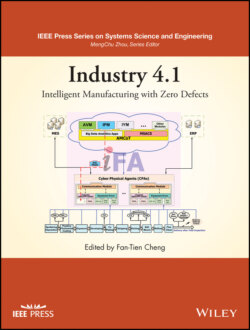Читать книгу Industry 4.1 - Группа авторов - Страница 36
2.1 Introduction
ОглавлениеVarious intelligent applications (such as predictive maintenance, virtual metrology, etc.) should be developed for achieving the goals of Intelligent Manufacturing. Taking predictive‐maintenance‐related applications as the illustrative examples, Chen et al. [1] installed one accelerometer, one acoustic emission (AE) sensor and two current sensors on a lathe to estimate the reliability, and remaining useful life (RUL) for cutting tools based on the logistic regression model using vibration signals. Suprock et al. [2] installed one strain gauge and one instrumentation amplifier with the Bluetooth transmitter on a cutting tool to calculate dynamic torque values, which are as accurate as the real measurements by the dynamometer. Ghosh et al. [3] developed an artificial neural network (ANN)‐based sensor fusion model for tool condition monitoring using cutting force, spindle vibration, spindle current, and sound pressure. Abuthakeer et al. [4] analyzed vibration signals based on the full factorial design and utilized ANN to validate the effect of cutting parameters on cutting tools during machining.
The fundamental steps for developing intelligent applications are depicted in Figure 2.1. As shown in Figure 2.1, before developing an intelligent application, the associated process/metrology data source needs to be acquired followed by appropriate data preprocessing. The main purposes of the aforementioned steps are briefly introduced in this subsection and more details can be found in the remaining subsections of Chapter 2.
Figure 2.1 Fundamental steps for developing an intelligent application.
Data Acquisition
Data acquisition is a basic and vitally important procedure to prepare and collect all needed process and metrology data for developing intelligent applications. In general, process data consists of sensing signals and manufacturing parameters. More details are introduced in Section 2.2.
Data Preprocessing
Without reliable data acquired from sensors and/or controllers, an intelligent application will not be feasible. To correctly interpret the acquired process and metrology data for deriving useful information, data preprocessing must be performed in advance.
Data preprocessing focuses on improving data quality through techniques such as de‐noising, synchronization, modification, and signal compression to enhance the transmission speed and storage efficiency as well as emphasize the major components and key features of signals. More commonly adopted techniques are introduced in Section 2.3 in three steps of data preprocessing: segmentation, cleaning, and feature extraction.
Intelligent Application Development
Based on the extracted features, final decisions and actions for the current situation can be carried out through learned functions by artificial intelligence (AI) approaches, including machine learning and/or deep learning techniques [5]. The ultimate purpose of the intelligent application is to extract useful knowledge and explanation from the AI models, so that correct decisions and actions can be made.
This chapter presents the existing techniques for data acquisition and data preprocessing in general; while the adoption of selected AI models for solving the problems in different industries, such as Thin‐Film‐Transistor Liquid‐Crystal Display (TFT‐LCD), solar cell, semiconductor, automotive, aerospace, chemical, and bottle industries, will be illustrated in Chapter 11 respectively.
